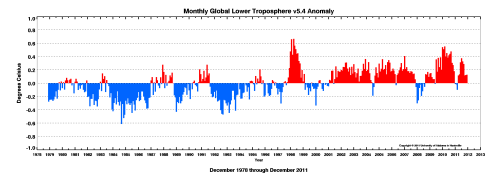Gavin Schmidt has presented information in his weblog post on Real Climate titled
which is incomplete and misleading.
His post starts with the text [highlight added]
Back in 2007, the IPCC AR4 SPM stated that:
“Most of the observed increase in global average temperatures since the mid-20th century is very likely due to the observed increase in anthropogenic greenhouse gas concentrations.”
This is a clear statement that I think is very well supported and correctly reflects the opinion of most climate scientists on the subject (and was re-affirmed in two recent papers (Jones and Stott, 2011;, Huber and Knutti, 2011)). It isn’t an isolated conclusion from a single study, but comes from an assessment of the changing patterns of surface and tropospheric warming, stratospheric cooling, ocean heat content changes, land-ocean contrasts, etc. that collectively demonstrate that there are detectable changes occurring which we can attempt to attribute to one or more physical causes.
He persists is using multi-decadal global model predictions as the tool to claim that the cause of global average temperatures increases over the last 50 years or so can mostly be explained by the increase in anthropogenic greenhouse gas concentration [and when he says “global average” he means “global annual average“] . In our article
Pielke Sr., R., K. Beven, G. Brasseur, J. Calvert, M. Chahine, R. Dickerson, D. Entekhabi, E. Foufoula-Georgiou, H. Gupta, V. Gupta, W. Krajewski, E. Philip Krider, W. K.M. Lau, J. McDonnell, W. Rossow, J. Schaake, J. Smith, S. Sorooshian, and E. Wood, 2009: Climate change: The need to consider human forcings besides greenhouse gases. Eos, Vol. 90, No. 45, 10 November 2009, 413. Copyright (2009) American Geophysical Union
we wrote
Unfortunately, the 2007 Intergovernmental Panel on Climate Change (IPCC) assessment did not sufficiently acknowledge the importance of these other human climate forcings in altering….. global climate ……… It also placed too much emphasis on average global forcing from a limited set of human climate forcings.
To this we should add that “the 2007 Intergovernmental Panel on Climate Change (IPCC) assessment did not sufficiently acknowledge the importance of NATURAL climate forcings in altering….. global climate ………”
Actually, it is straightforward to shed doubt on Gavin’s (and the IPCC) claim. If the increase in anthropogenic greenhouse gas concentration were so dominate we would expect the global average [annual] lower troposphere temperature to more-or less monotonically continue to rise in the last decade or so. This clearly has not occurred, as illustrated, for example, in the figure below for the lower troposphere [from RSS; Figure 7]
and from the UAH analysis (see)

The first tic mark on the x-axis in the RSS figure is 1979.
The lower tropospheric ~global annual average lower tropospheric temperatures have been essentially flat for at least 10 years, presumably due to other human climate forcings, solar forcing, decadal and longer natural variability and/or radiative feedbacks.
If Gavin were correct, we should also see the lower stratosphere continue to cool. As shown below (from RSS, figure 7), there has been no significant cooling for over 17 years!
Gavin is failing to see this complexity in the climate system. It is quite puzzling as most all climate scientist accept a positive radiative forcing from the human addition of greenhouse gases, but many of us do not accept that is the only first order effect, nor that it is the most dominate in terms of the effect of these forcings on society and the environment.
He may yet be correct for 50 year time scales, but the recent evidence he refers to is actually working to refute his hypothesis.
In this context, he also has ignored the implications from the recent Loeb et al 2012 paper which posted on;
In that post, I wrote
Jim Hansen concluded in 2005 that the decadal mean planetary energy imbalance at the end of the 1990s was
,…..0.85 Watts per meter squared is the imbalance at the end of the decade.”
This value falls within the uncertainty range of the Leob et al 2012 study. However, we are 13 years since the end of the 20th century, so Jim Hansen’s value for the imbalance must be larger (~0.95 Watts per meter squared from GISS?).
This question about whether or not the IPCC model predictions (as represented by the GISS models) are still consistent even with the large Loeb et al estimate should have been a major part of their article. The Loeb et al 2012 even cited the Hansen paper but did not take the next step and complete model and observational comparisons. That the IPCC models are close to being refuted with respect to the magnitude of global warming even with the large Loeb et al values is an unspoken result of their findings. They missed a major implication from their results.
Gavin is very selective when he seeks to defend the dominance of anthropogenic greenhouse gases with respect to global annual average temperature changes. In reality, Gavin’s conclusion on the role of the anthropogenic emissions of greenhouse gases as dominating changes in climate statistics is close to being refuted.



